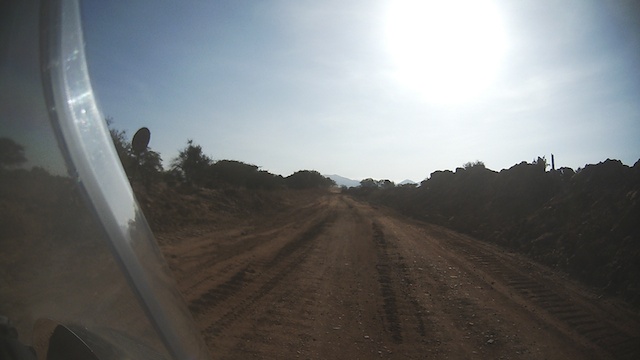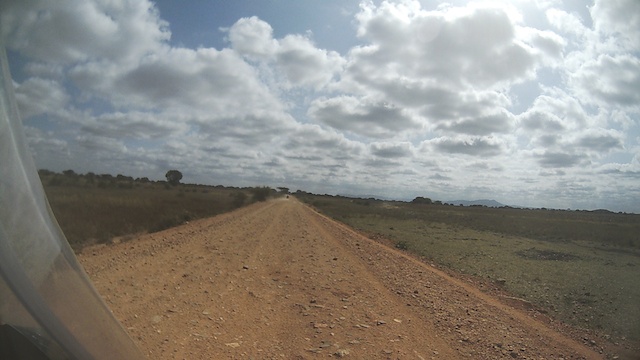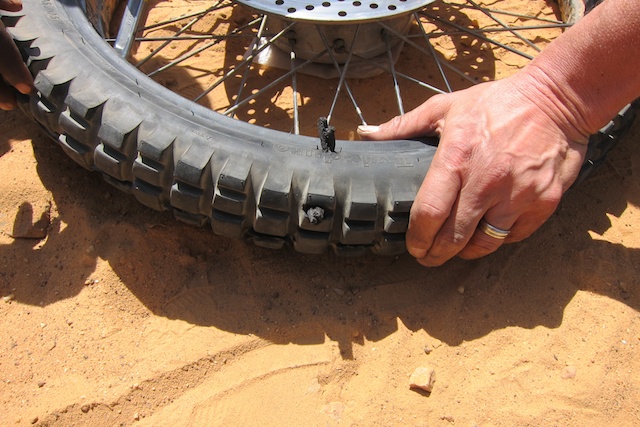Day 27 to Day 29 - June 23rd–25th

Helge has become an unadulterated “Essel-tonian,” adhering strictly to Dr. Esselstyn’s diet. I’m a modified “Essel-tonian.” Perhaps we have Essy to thank for the fact that we both escaped the stomach flu that the others got. Even so, eating according to the Esselstyn rules has been a challenge on this trip because vegetables are often washed in water of dubious quality; eating them raw can easily bring on persistent stomach problems. It’s also extremely difficult not to eat meat in Africa. So we must choose between dying of heart attack by eating oils and fats or dying of amoebic dysentery from eating uncooked vegetables. Helge has been having fairly detailed discussions with the cooks everywhere we have a meal. We have been stopping for lunch every day. We take a break every hour on difficult roads and usually every two hours on easy roads, mainly to hydrate. There is a big difference between Malawi and Tanzania. Tanzania has more than twice the population and the gross domestic product per person is 2/3 higher. The agriculture in Tanzania is more organized and on larger plots. This is an Indian-owned tea plantation that spans about a half-mile along the road.

Buildings here are also very different, many more featuring metal roofs. We’ve seen many more bicycles and motorbikes here than in Malawi:

Tanzania is not laissez faire about speeding. There are speed traps and check points everywhere with policemen ever present.

Helge is generally in front and spots the radar traps. We stopped for lunch at a quaint lodge that Helge is reconnoitering for a future trip.

The thatched roof and mud wall architecture seems modest at first glance, but the lodge is gorgeous both inside and out.


The bad news is the proprietress has received reports that the 600-700 mile road we were about to travel on from Iringa to Arusha is a total disaster for motorcycles – lots of sand and gravel. Unfortunately, it is on the “must do” list. The Chinese are paralleling this road, and in a year or more it will be gone. Helge views it as running a river that is about to be dammed– it’s there, we’ll never have a chance to do it again, so now’s the time. We covered 500-600 miles of road that looked like this:




The road required our constant attention. Our motorcycles took a terrible beating due to the washboard surface, sharp rocks, and occasional patches of deep sand. I ended up off the bike and in a ditch, and Vince ended up in the same ditch but still on his bike. Helge trained his 400 mm telephoto lens on a spot that we traversed; he claims to have caught me falling down, but I think he is just very good at PhotoShop! Just as I was marveling at how much abuse our tires could take, I got a puncture in my tubeless tire through tread and the sidewall. A car following me got a puncture at the same location.

Since it was a severe puncture, we tried installing a tube.

I had the wrong tube and it could not be installed without puncturing it, so Helge decided on an unorthodox patching technique: two plugs in the tread, one plug in the sidewall.

This tire went flat three more times in the two days that followed. Finally, I rode the motorcycle more than a mile to our destination on a flat tire without damaging the rim.One time the front tire went flat at high speed on the highway because the plug had worked its way out of the tread. It may have been the heat from going too fast, or perhaps the hole was just too big to plug. We learned several lessons from this:
- You have to select carefully the plugs you use for tubeless tires. If the plug is too wet and sticky, it may not be able to take the heat.
- You have to go light on reaming out the hole; a small hole is easier to plug than a large hole.
- Do not use a 12V Harbor Freight compressor; use one that is more robust. I had to repair the compressor twice in four tire changes.
- Experiment with other ways to repair a tire using mushroom plugs and sealing cement techniques on particularly persistent punctures.
- Always be sure you have the right tube.
Part of the Islamic tradition is not to think about bad things that can happen. The theory is that the more you think about it, the more you put yourself at risk of that bad thing happening. Tanzania is more Muslim than Christian, and the Islamic influence increases as we head further north. Clearly I should have followed their example and not thought about my vulnerable tires. As we continued over the rest of road, we ran into our share of animals and primitive transportation.


We eventually arrived at a lodge south of Arusha. Tomorrow we will have a leisurely ride to Arusha to meet the wives, Heather, and the grandchildren at the picturesque Ngore Sero Mountain Lodge.
Back to Top

- rolex replica horloges
- cheap pandora charms
- https://mymathdone.com/
- cheap pandora
- replique des montres
- Hammer Of Thor Asli Di Medan
Add A Commentrolex replica horloges - July 8, 2017, 9:32 am
Both cheap and gorgeous fine imitation watches;goedkope horloges filling your success sty le!
rolex replica horloges Replica watch online.
skill - July 10, 2017, 6:37 am
Great Article it its really informative and innovative keep us posted with new updates. its was really valuable. thanks a lot. cheap pandora charms very good.
Kenton P. Taylor - July 27, 2017, 11:04 am
As we all know that every student will need https://mymathdone.com/
for their math homework help at some point during their education.
marn - July 28, 2017, 8:16 am
stone settings cheap pandora and sophisticated Miami-style colours, such as fancy pink, teal and frosty mint.
rita ora - December 3, 2017, 6:48 am
Aujourd'hui, la série montres replique Tank est principalement divisée en cinq styles. Réservoir Louis Cartier en 1922, toujours fidèle à la conception originale, enracinée dans le style Art déco. 1989 Le lancement de la montre Tank Américaine suit l'apparition de la replique montre Tank Cintrée (1921), bien que la taille soit un peu plus grande, plus Founder, mais l'étui continue de montrer un design incurvé. En fait, Tank Américaine Cartier est le premier étui étanche avec montre courbe.
rumah herbal - March 13, 2018, 6:14 pm
thanks for the article which is very useful, with this post possible for myself and others can add a little insight into what you describe through this blog, even for an author of this blog include people who are good personality throughout his life because it can bring guests from various other parts of the world not just to be a special guest at this very interesting blog.
Obat Titan Gel Asli Di Palembang
Obat Anabolic Rx24 Asli Di Palembang
Obat Kuat Forex Asli Di Palembang
Obat Viagra 100mg Asli Usa Di Palembang
Obat Kuat Cialis 80mg Asli Di Palembang
Obat Potenzol Perangsang Cair Di Palembang
Obat Blue Wizard Perangsang Cair Di Palembang
Jual Obat Hercules Cair Di Medan
Obat Pelangsing Green Coffee Bean Di Medan
Obat Erogan Asli Di Medan
Alamat Hammer Of Thor Di Medan
Testo Ultra Di Medan
Jual Cream Develope Sex Asli Di Medan
Obat Hermuno Intoxic Capsul Herbal Anti Parasit
Distributor Obat Titan Gel Asli Di Medan
Produk Pusat Anabolic Rx24
Jual Obat Capsul Forex
Toko Vimax Asli Di Medan
Pusat Obat Kuat Viagra 100mg Asli Di Medan
Jual Cialis 80mg Obat Kuat Asli Di Medan
Jual Semenax Asli Obat Penyubur Sperma Di Medan
Tattonox Obat Penghilang Tatto Di Medan
Jual Selaput Dara Buatan Asli Jepang
Alat Bantu Vagina Center Flashlight Di Medan
Jual Vagina Getar Suara Silicon Di Medan
Boneka Cantik Full Body Silikon Asli Di Medan
Jual Penis Getar Goyang Alat Bantu Sex Wanita
Jual Penis Mutiara Getar Putar Di Medan
Jual Penis Ikat Pinggang Alat Bantu Sex Wanita
Toko Penis Tempel Jumbo Silicon Di Medan
Distributor Kondom Sambung Jumbo Di Medan
Distributor Kondom Duri Silicon Bergerigi Di Medan
Jual Kondom Getar Silicon
Jual Vakum Alat Pembesar Penis
Jual Alat Pro Extender Asli Alat Terapi Pembesar Penis
Jual Viagra Asli Usa 100mg Obat Kuat Pasutri
Jual Kianpi Obat Penggemuk Badan
Jual Grow Up Asli Di Medan
Cream Titan Gel Asli Di Bekasi
Jual Titan Gel Asli Di Jakarta
Alamat Hammer Of Thor Di Medan
Obat Ericfill Asli Di Medan
Obat Titan Gel Di Surabaya
Obat Anabolic Rx24 Di Surabaya
Obat Forex Asli Di Surabaya
Obat Viagra 100mg Asli Usa Di Surabaya
Obat Cialis Asli Di Surabaya
Obat Potenzol Di Surabaya
Obat Blue Wizard Di Surabaya
Obat Hercules Asli Di Medan
Obat Pelangsing Asli Di Medan
Obat Kuat Erogan Asli Di Medan
Obat Forex Asli Di Medan
Obat Vimax Asli Di Medan
Obat Viagra Asli Usa Di Binjai
Obat Cialis Tadalafil Di Medan
Obat Blue Wizard Asli Di Medan
Obat Potenzol Asli Di Medan
Add A Comment